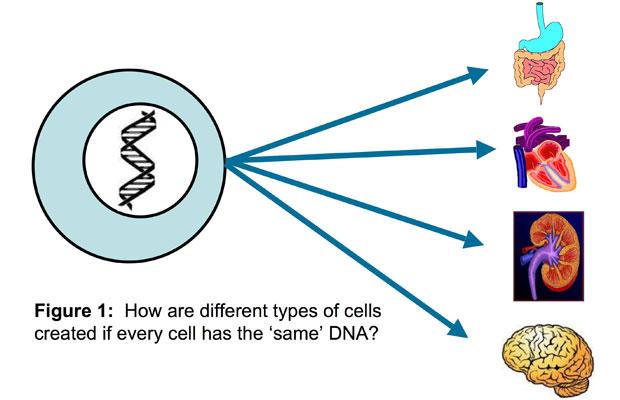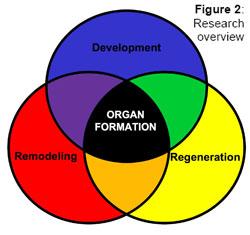Research & Teaching


With a few exceptions, the cells found in a multicellular organism contain the same DNA in their nuclei (each cell has a blueprint of the entire organism). During development different types of cells are created to generate functional tissues and organs. How are different types of cells created during development if genetic information encoded by their DNA is the same? This central question has puzzled scientists for decades and is the focus of our current research (Fig. 1). We seek to identify and characterize the genes that mediate the formation and patterning of tissues and organs during embryogenesis.
BIG PICTURE: Our research aims to discover the basic mechanisms of vertebrate (1) organ development, (2) remodeling, and (3) regeneration/repair (Fig. 2). This three-pronged approach will provide a deeper and more complete understanding of the complexities underlying organ formation. Unraveling the intricacies of normal organ development, as well as tissue remodeling and regeneration have important implications for many areas of human adult and child health. For example, in the United States alone, there are currently over 20 million people suffering from a variety of renal diseases. The considerable morbidity and mortality resulting from long-term dialysis treatment, as well as the scarcity of suitable donor organs available for transplantation, reflects the urgent need for the development of renal replacement therapies. To develop improved methods of treating nephric (kidney) diseases, an understanding of the structure and function of the excretory system at multiple levels is imperative. The results of our investigations will contribute to the understanding of proliferative and degenerative kidney diseases, and the possibility of harnessing the regenerative capabilities of nephric tissues as part of future therapeutic interventions. Consequently, the basic scientific studies of today hold great promise in many areas of human adult and child health, where the discoveries of today develop into the treatments of tomorrow.
Organogenesis: Development, Remodeling, Regeneration
The primary objective of our research is to understand how functional organs are created. During development cells are constantly bombarded with signals from neighboring cells (e.g. growth factors) and from their local environment (e.g. temperature, pH). Upon receiving these cues, cells must properly interpret these signals and subsequently respond in an appropriate manner (Fig. 3). Although many of the mysteries of biology have been revealed over the years, we still lack a thorough understanding of the cellular language (molecular mechanisms) used by organisms to create and pattern tissues and organs. Our research team examines three distinct processes to gain a more complete understanding of how organs are created including: (1) organ development and patterning – role of the Notch signaling pathway during nephrogenesis (kidney development) and cardiogenesis (heart development) (2) organ remodeling – induction of precocious metamorphosis after exposure to herbicide, and (3) organ regeneration – repair/restoration of injured nephric tissues.
Why use an amphibian model system (Xenopus laevis)?
The majority of the research conducted in our lab takes advantage of the versatile, amphibian model system Xenopus laevis (common name: African clawed frog). Years of research have demonstrated that the genes necessary for controlling growth and differentiation of cells in "simple" model organisms (e.g. flies, worms, fish, frogs) not only have easily recognizable counterparts in mammals, but they often perform similar functions. For years, amphibian species have been used to ask, and answer, complex developmental questions. The external development of Xenopus embryos has facilitated the study of early cell fate decisions, patterning of the basic vertebrate body plan, and early organogenesis. These amphibians are non-seasonal breeders that produce hundreds of embryos at a time. The large embryos are amenable to in vitro manipulation using techniques such as microinjection and microdissection. Of particular importance for our research is the plethora of genes and gene products that have been examined in recent years, providing useful molecular markers of cell fate decisions occurring during development. Lastly, the early stages of the Xenopus life-cycle are extremely rapid (functional organs are produced in swimming tadpoles in approximately 2-4 days), making this amphibian an extremely valuable model system in which to examine organogenesis (especially for undergraduate research assistants).
Specific Project Descriptions:
